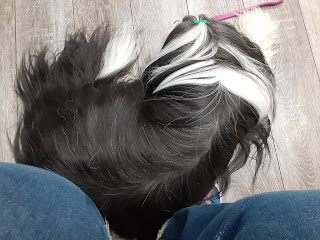Phase Two
 |
| Relaxed (but aware) at my feet. |
Vaccination day. Did much better than I anticipated given she boarded here a week ago; she didn't tremble once and gave only a single whine. Treats from the doc helped smooth that last bit out.
Summer's been on anti-anxiety meds for a week now, long enough for canines to start seeing benefits (in humans is usually closer to two weeks). She never looked outright drugged but a couple times she seemed to be...figuring something out? Somewhat restless? She couldn't find a good spot to rest sometimes on the second and third days. A bit pacey, indicating mild stress, but no panting.
On day three or four we ran into friends (including canine) on our walk. We were in the courtyard and mostly standing in her "problem spots" where the sound reverberates differently and sets off her extremely delicate noise sensitivity. This can be very high stress for her. I noticed, however, that while she was still distracted and orienting toward my door the signs of a dog quick to anxiety - wide panting, trembling, easy startle, even ducking around me once in a while - were completely absent.
...and behaviorist/trainer mind clicked in and said, "I can redirect what I am seeing here."
Of course, I'll have to retest because it still could have been sedation rather than the medication. I will say, however, that when I've worked with clients using this method I would get snapshots of the dog - before medication, maybe during adjustment, after medication. One can see the difference in the dog when a med kicks in and again when an appropriate training regimen is applied.
I'm pretty sure that was a good snapshot on Summer.
Beyond that we're working on remembering that the balcony is safe. This year she somehow developed the idea that walking on the road was terrifying, so that's definitely a good place to test med efficacy. If I can get the trembling to at least a minimum I think I'll see improvement on a lot of things, but especially on shaping her heel. I've tried to work on a show heel with her but no dog is going to respond to the intricate training that can involve if she is in a constant state of anxiety or panic. The behavior I want is in direct opposition to that part of the brain screaming at her to pull and keep pulling. I've used my tools that should work on a healthy dog or could work in a case of mild to moderate anxiety. An overarching anxiety issue is not a healthy state, so we are now using medical science to bring her closer to healthy so behavioral science can be applied once more, and likely more successfully than before. It's still a journey - the anxious ones are - but it's certainly one I've made many times before. I'm really looking forward to where we can get together.



Comments
Post a Comment